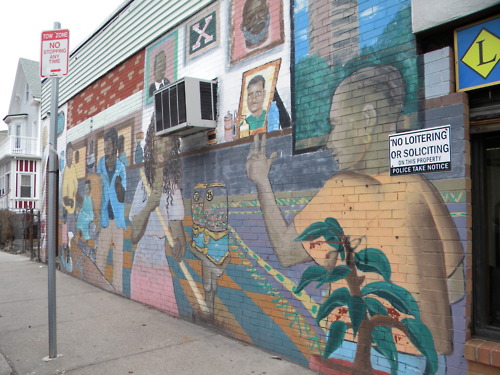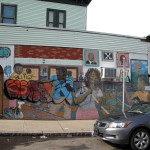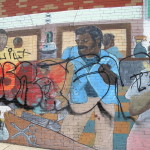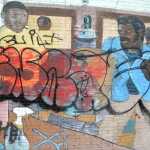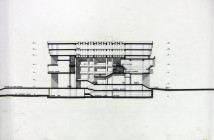 AFTER: My First Haircut, on the side of Lawson’s Brothers Hairstyling Salon, Egleston Square, Jamaica Plain. Photo: Courtesy of Anulfo Baez
AFTER: My First Haircut, on the side of Lawson’s Brothers Hairstyling Salon, Egleston Square, Jamaica Plain. Photo: Courtesy of Anulfo BaezA little over a year ago, I wrote a short essay for the Boston Society of Architects titled "Documenting Boston Murals: What they say and how they say it." In it, I write about my quest to photograph and document Boston’s rich mural tradition which goes as far back as the 1960s and the Black Arts Movement. I also briefly discuss the collective nature of murals and what that means for their preservation and stewardship.
This past weekend as I rode the bus into work, I noticed a mural on the side of Lawson’s Brother’s Hairstyling Salon in Egleston Square, vandalized with destructive graffiti writing.
While I’ve documented more than one hundred murals in Boston, I’ve only seen one mural vandalized with graffiti. That’s great, because it tells me people take pride in the images and stories painted on the empty walls surrounding their community. Murals are one of many ways city officials have been retaliating against graffiti writers for years, but when a mural is in disrepair and left to fade to the point of being barely recognizable, isn't it time to invest in our artists and communities and commission new murals or conserve historically important ones?
The mural in question is titled My First Haircut, completed in 1997 and was executed by B.Y.C.C (now known as the Mayor’s Mural Crew). In this mural, small in comparison to most of the murals I've seen around the city, viewers are invited inside a barbershop where a boy gets his first haircut. This mural, like most in the City of Boston or those in other cities across the country, celebrates diversity of class and ethnicity, as well as the value of building a strong community. The mural has faded and hasn't been retouched since 1997.
Boston, in spite of being at the forefront of the development of the mural movement in the 1960s, does not have a comprehensive mural program like those in cities such as Los Angeles and Philadelphia. Programs like Mural Arts Program in Philadelphia and the Mural Conservancy of Los Angeles aim at commissioning new murals and conserving, protecting and interpreting existing ones. Our artists, our communities and our empty walls could benefit from such program.
Only a couple of the murals painted in the 1960s and 1970s in Boston remain and one of these, located in Chinatown, has disappeared under an advertisement for a Chinese landscape painting from the Museum of Fine Arts, Boston.
The moral of the story is that unless a mural has a designated steward(s) in the community, it will quickly fade and become just another open invitation for vandals to leave their mark on.
- BEFORE: My First Haircut, on the side of Lawson’s Brothers Hairstyling Salon, Egleston Square, Jamaica Plain. Photo: Courtesy of Anulfo Baez
- AFTER: My First Haircut, on the side of Lawson’s Brothers Hairstyling Salon, Egleston Square, Jamaica Plain. Photo: Courtesy of Anulfo Baez
- AFTER: My First Haircut, on the side of Lawson’s Brothers Hairstyling Salon, Egleston Square, Jamaica Plain. Photo: Courtesy of Anulfo Baez
- AFTER: My First Haircut, on the side of Lawson’s Brothers Hairstyling Salon, Egleston Square, Jamaica Plain. Photo: Courtesy of Anulfo Baez
- AFTER: My First Haircut, on the side of Lawson’s Brothers Hairstyling Salon, Egleston Square, Jamaica Plain. Photo: Courtesy of Anulfo Baez

